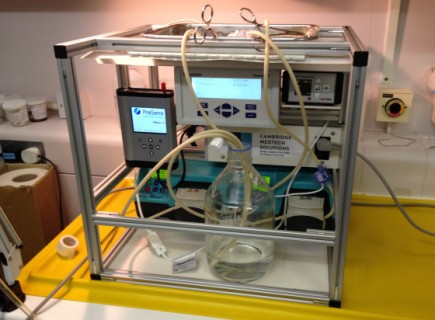Tissue Engineering x Systems Engineering
October 2, 2014
Excellent! You’ve made good progress with the whole organ perfusion / tissue engineering protocols, and now you are ready to proceed with the development of a more advanced bioreactor. Whether is it for on-going clinical research or it is the final system, you need to start the conversation with the systems engineers, who will add a different perspective as you all work towards a robust and capable outcome.
Pathway from Source to Recipient
From the start, the systems engineer will want to map out the detail of the use case flow chart, which will answer the questions “What and Why and When, and How and Where and Who?”
This might contain multiple starts, intersections and endpoints – for example, a biologically-derived scaffold recellularised with the recipients own stem cells, using a growth medium – and there are typically more questions than answers when first discussed.
To enable this, we recommend the preparation of the outline Target Product Profile (TPP) at an early stage in the clinical research / development programme, which considers the therapy, the efficacy, how the therapy is to be deployed and used, who makes the decision to use the therapy (and based on what evidence), and what the ideal claims would be.
The TPP embodies the notion of beginning with the goal in mind, and establishing it often results in a clear understanding of the regulatory pathway, and the standards and classifications that need to be met.
Mapping out the pathway will also help the whole team (clinical, engineering, commercial) to visualise and develop a common understanding of what they expect and want, to challenge assumptions, and to identify operational constraints (tissue and fluid availability, technology availability, cost, size, weight, staffing levels, physiological limits of the therapy, and operational limits of the system).
In time, this will enable the preparation of the User Requirements Specification and the Product Requirements Specification.
Risk Management
Risk assessments are not just an essential component of any system or therapy development programme – they can also be a very effective design input, and can help with the organisation of the pathway.
The challenge is that many of the standard tools and techniques used are time consuming, and are based on a single snap-shot of the design. Unfortunately, this does not fit well with complex systems such as tissue engineering bioreactors that are progressing through a rapid development programme.
We favour the use of a ‘real-time’ risk assessment approach that is quick, efficient and effective. Crucially, it should also enable risk control interplay between electro-mechanical and software elements, and is consistent with the relevant directives and standards such as ISO 14971:2012 and IEC 62304.
Advanced Testing
Testing is an area of systems engineering that is too often compromised due to the lack of samples, systems or time. It can also be compromised by only testing up to the design limits, rather than the likely operational stresses of everyday use which can combine in unexpected ways to cause a system to fail.
Multiple environment over-stress testing (MEOST) is a complex but powerful technique for testing combined interactions of all stresses, where the primary objective is to find the failure modes so they can be addressed. It can also be used to compare the robustness of two systems or design iterations.
Experience shows that this approach is quicker and cheaper than traditional testing, less prototypes / systems are required, less tests are carried out, but more failure modes are identified. This approach is not just limited to systems engineering and reliability engineering – it can also be used to evaluate the robustness of some therapies as well.
Cost
Reducing healthcare costs, whilst providing optimum levels of patient care, has consistently been a priority for healthcare leaders for the past few years, and is expected to continue.
Whilst the health economics of the different regenerative medicine / tissue engineering approaches are yet to be fully understood, it is recognised that costs need to be aligned with mainstream healthcare reimbursement systems.
Therefore, until the models can be validated, you should be pragmatic and look at every opportunity to reduce the costs per therapy. In our experience, the biggest savings can be achieved by avoiding expensive consumables (fluids, functional components and sensors), simplifying the design of the disposable set, avoiding the need for active thermal control during transport, and minimising the staffing resource required (peak and FTE).
These are some of the key considerations for any tissue engineering bioreactor system – for perfusion or persufflation; biologically-derived or synthetic scaffolds; decellularised (decellularized) or recellularised (recellularized); whole organs or ATMP; hypothermic, normothermic or hyperthermic – and you should start considering them as early in the development process as possible.
Overall, it is easier to consider these matters at the start, and to mitigate against issues that can be challenging, costly and time-consuming to resolve later in the development programme.
First printed in regen, September 2014



